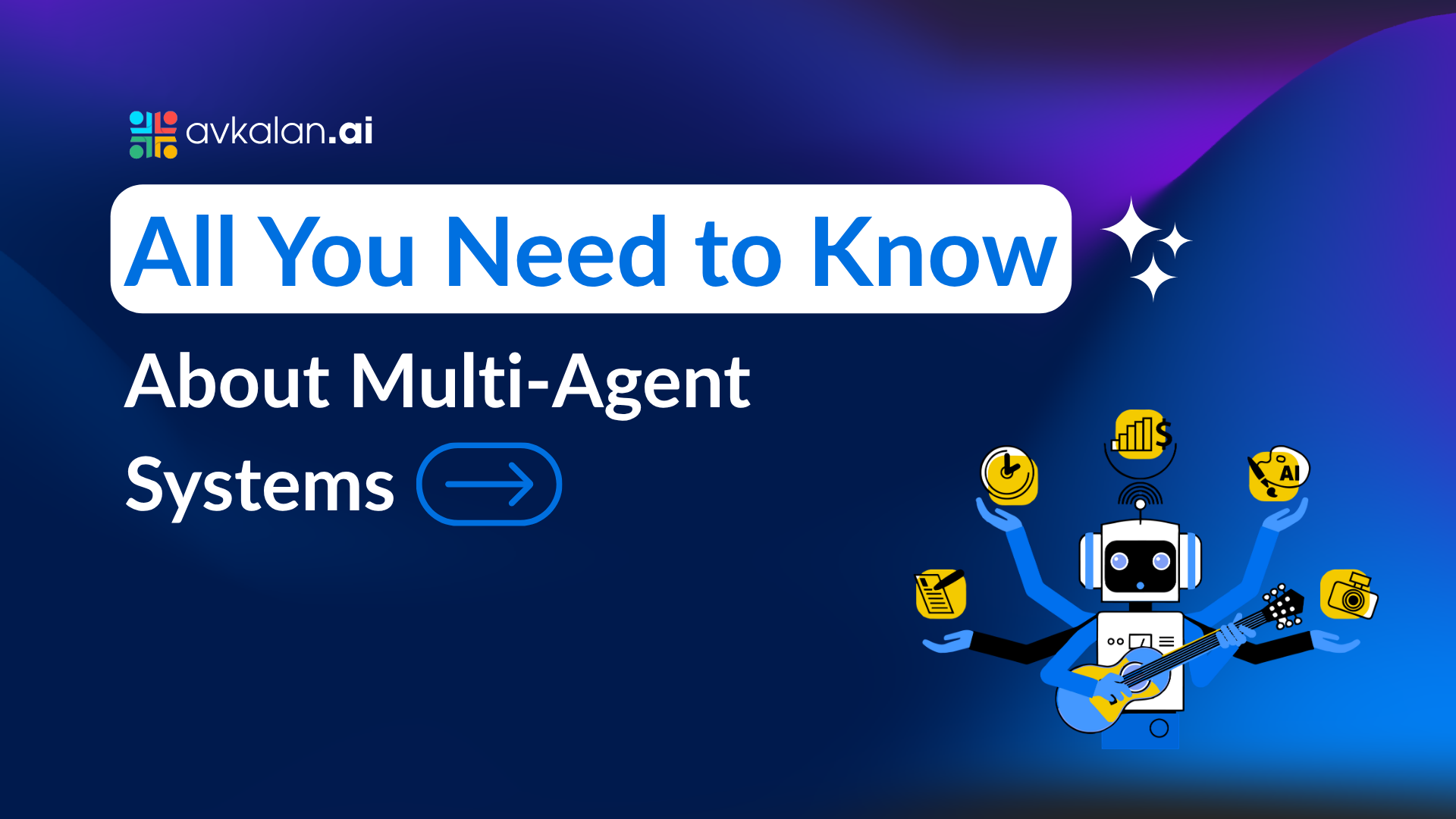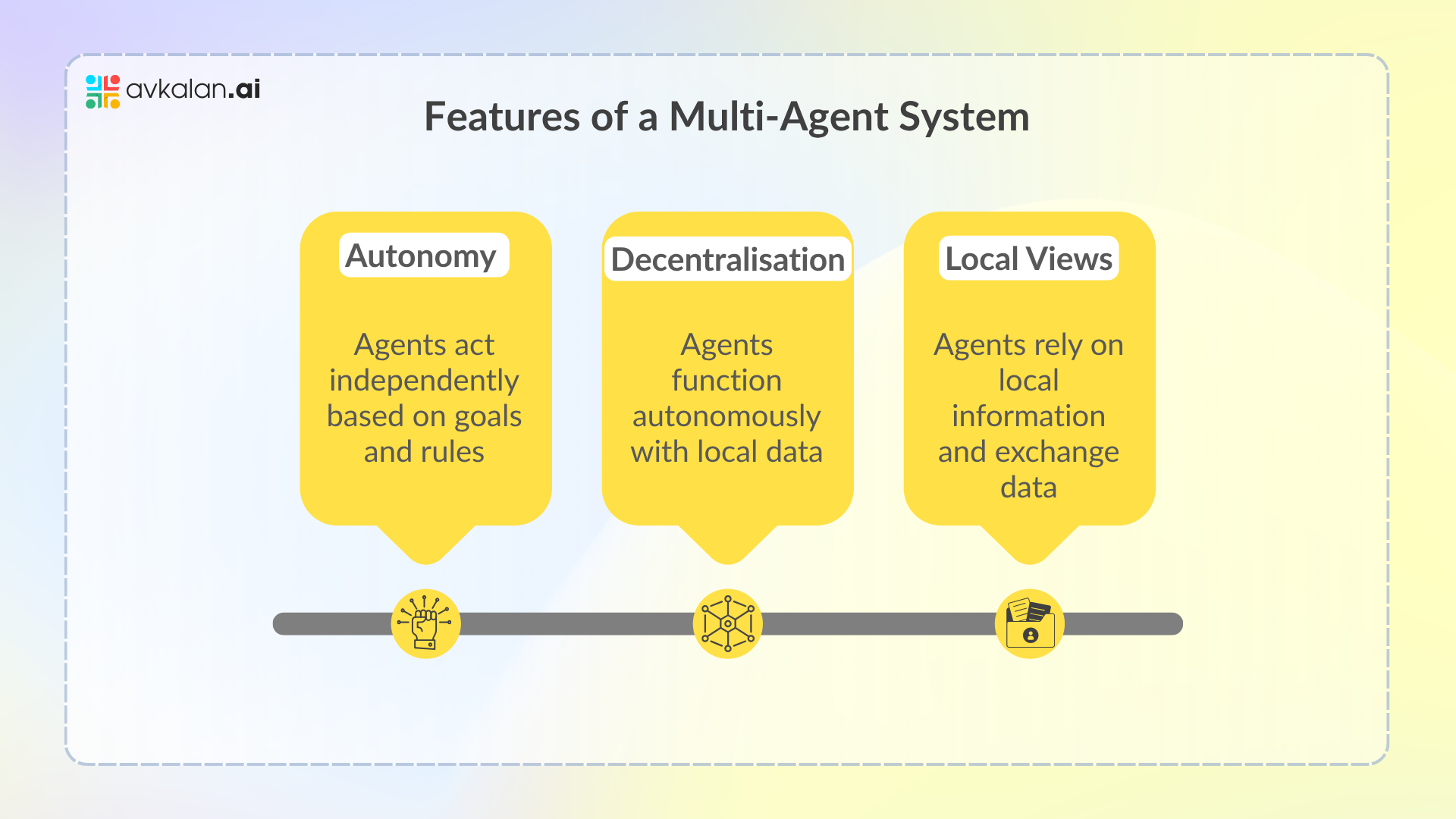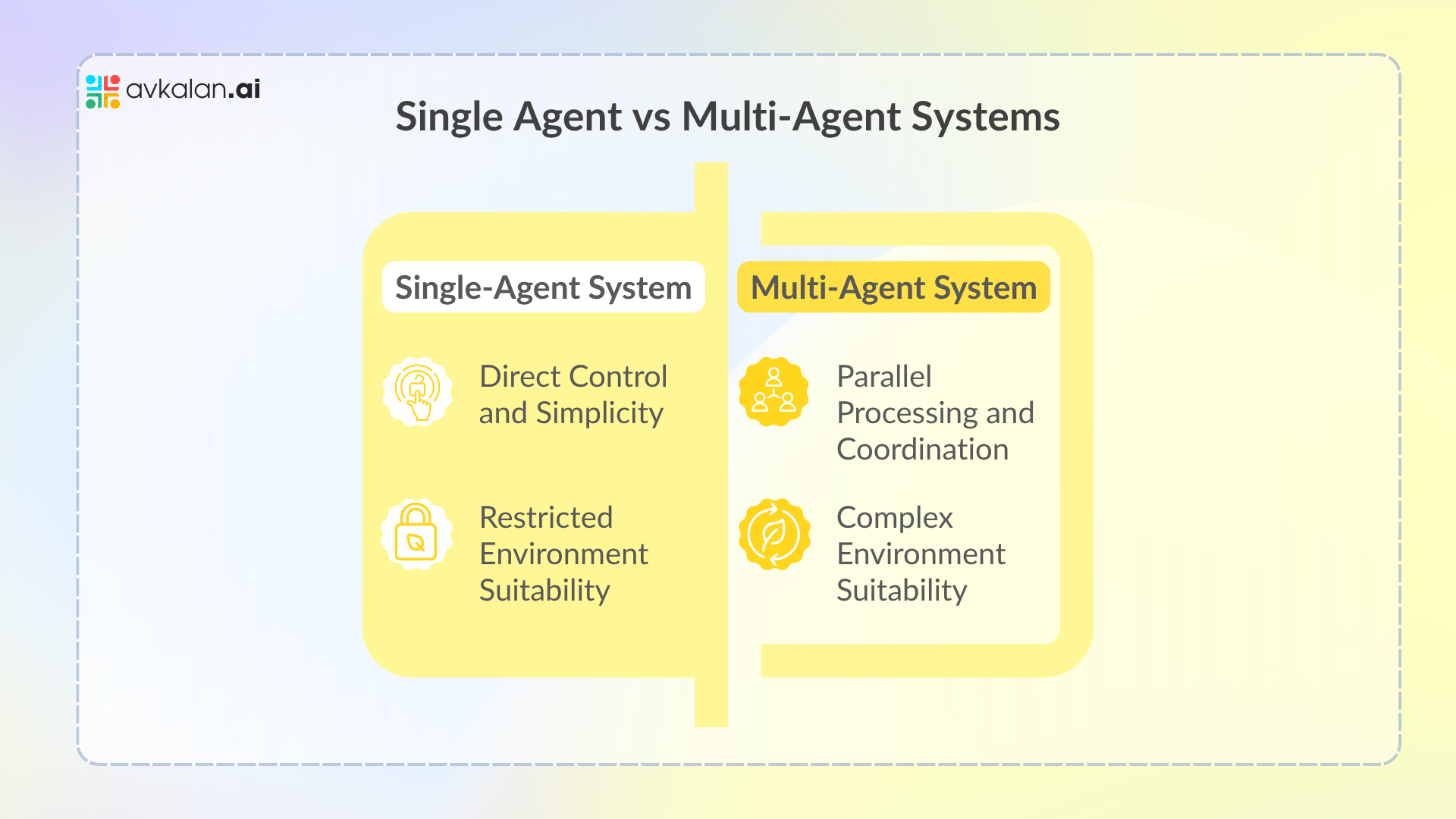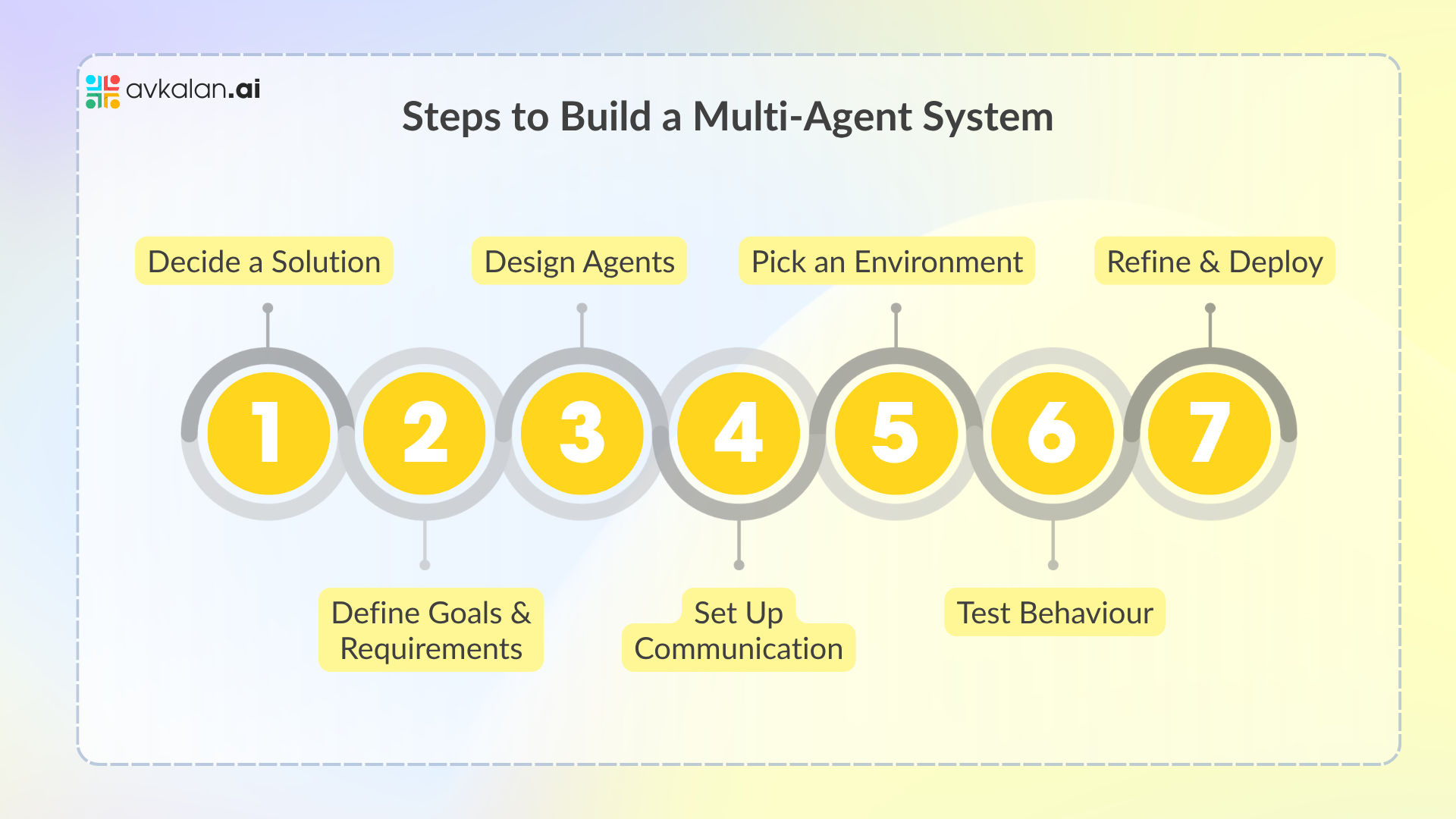
Multi-agent systems can be a better option than a single AI agent, depending on certain kinds of activities. Various AI agents performing various activities interact with each other to meet goals in multi-agent systems. Warehouse systems and smart grid controllers are real-world examples of AI agents, which use multi-agent systems to function properly. Do you want to know in detail about multi-agent systems? This blog post discusses what they are, their key features, how they differ from single-agent systems, their benefits, and other important things you should know about them. Let’s dive in.
What is a Multi-Agent System?
A Multi-agent System (MAS) has multiple AI agents that work together in a shared environment to meet certain goals. Such a system is usually built to perform activities that are too big, complicated, and decentralized to be handled by a single AI agent. Every agent in a multi-agent system may function autonomously and perceive and analyze the environment. It makes decisions and takes the required actions to meet goals.
Features of a Multi-Agent System
Here are the key features of a multi-agent system:

- Autonomy : The autonomy of a multi-agent system helps every agent to understand information and act autonomously depending on the goals and following the rules. Such autonomy allows agents to make decisions and adjust their activities without consistent input or guidance from other AI agents.
- Decentralization : Decentralization means every agent in a multi-agent system functions autonomously with local data. However, it doesn’t mean zero coordination. Certain MAS systems may have a lightweight central control, like hybrid architectures. The AI agents can individually perform activities and achieve the system goals via interaction.
- Local Views : Every agent has a local perspective. Agents primarily rely on local information; however, they can exchange data as and when required. None of the agents are fully knowledgeable about the full system. They know only the relevant elements of the specific activity.
Single Agent vs Multi-Agent Systems
A single-agent system functions with a single and independent entity to manage tasks, which works perfectly in a restricted environment with direct goals. Siri is one of the most famous AI assistants that work independently. A single-agent system is perfect for doing tasks prioritizing direct control and simplicity without the requirement to respond to and coordinate with other agents.
On the contrary, multi-agent systems comprise multiple agents that interact in the same environment. Such systems depend on distributed tasks where every agent works depending on individual roles and objectives. Such a decentralized framework helps multi-agent systems to manage an environment requiring parallel processing and multiple viewpoints even if agents tend to function autonomously. Now that we understand the key differences between single-agent and multi-agent systems, let’s explore the multi-agent system’s benefits.

Benefits of Multi-Agent Systems
Here are the key benefits of multi-agent systems:
- Flexibility and Adaptability : Every agent can autonomously respond to any changes. It helps the system to swiftly adapt to unexpected and new conditions.
- Higher Scalability : Multi-agent systems more easily manage huge workloads to meet goals or integrate new features to upscale their capabilities by using agents as required. A multi-agent financial analysis system may include new agents to process extra data streams as the trading volume increases.
- Increased Fault Tolerance : When multi-agent systems work together, an agent can take over when another agent fails to function properly. A multi-agent system may improve fault tolerance, however it requires redundancy techniques, such as agent replication, task reallocation and failover strategies. This facility boosts their resilience compared to single-agent systems.
- Smarter Problem Solving : As multiple agents work on various elements of a specific task, they can fix complicated issues more efficiently in a segregated environment.
Examples of Multi-Agent Systems
Here are the most common examples of multi-agent system implementation:
- AI-Driven Marketplaces : AI agents may represent sellers and buyers, manage inventories, negotiate prices, and adjust offerings depending on supply and demand in AI-driven marketplaces. All the AI agents function autonomously and interact with others, which builds a dynamic marketplace environment that changes depending on the changing scenario. The agents can build an integrated and customized treatment plan suited to ongoing events and new information by coordinating data.
- Warehouse Robotics : AI agents function as robots who can perform tasks such as collecting, sorting, and packing items in a warehouse. Every robot independently navigates a warehouse and interacts with others to improve movement routes, fix loopholes, and deliver orders quickly to shift order structures and volumes.
Are Multi-Agent Systems the Right Option for You?
Consider the adaptability and complexities of your project requirements to decide if a multi-agent system works better than a single-agent system. Multi-agent systems are mostly used for large-scale and dynamic activities with decentralized authority.
You should ask yourself these questions below before using multi-agent systems:
- Will a centralized system be a risk factor or bottleneck?
- Does a project need to manage many locations and components simultaneously?
- Does the environment keep changing frequently and requiring real-time implementation?
- Do task elements require coordination or interaction to be effective?
- Is extreme fault tolerance required to prevent system disruptions?
If your reply is “Yes” to most of the questions above, a multi-agent system may be the right choice.
The Most Effective Multi-Agent System Practices
Here are the best practices to follow when implementing a multi-agent system:
- Define Precise Objectives for Every Agent : Confirm every agent performs a specific role or fulfills goals suited to your system’s intent to strengthen coordination and conflicting activities.
- Build Potent Communication Protocols : Design a trusted communication framework so AI agents can coordinate well and share information with each other if real-time updates are complicated.
- Make Scalable Designs : Build a scalable multi-agent system so you can add or remove agents with your changing requirements. Thus, the multi-agent system can scale up with no interrupting current agents.
- Monitor and Handle Agent Interactions : Track periodically to check how AI agents interact to prevent issues, such as loopholes, unhealthy competition, and resource deficiency, in complicated systems.
- Implement Strict Security Measures : Prioritize security protocols to manage data, communicate, and protect against risks such as malicious attacks and data breaches in systems with numerous agents.
- Decide Adaptively : Utilize algorithms that make agents adapt their behavior depending on the evolving environmental data and conditions. It encourages resilience and flexibility in the unknown faces.
How to Build a Multi-Agent System
Follow the steps below to build a multi-agent system:

1) Decide a Solution
You should decide if you want to build a multi-agent system or use a current platform, which supports multiple agents. DIY involves customization, however it needs rich development sources. Platforms usually offer built-in tools to manage data, coordinate agents, scale operations, and streamline the development process.
2) Determine Motives and Requirements
You should clearly know what you want your multi-agent systems to achieve in terms of functionalities, interactions, and requirements. Find out the required kinds of agents and their functionalities in the system to fulfill your business goals.
3) Build Your Agents
Design an architecture for every agent, including logical decision-making, adaptability, and data processing abilities. Customize the architecture suited to your requirements considering how every agent interacts with the surroundings.
4) Implement Communication and Coordination Methods
Use communication protocols to promote data coordination and sharing among agents. Select methods, such as shared repositories, message delivery, etc., depending on how frequently agents should be required to communicate and upgrade each other.
5) Select the Right Environment
Choose an environment, be it physical, digital, or hybrid, that supports your AI agent operations. You should configure your environment to confirm it accommodates data flow, interactions, and physical limitations that may impact the agent performance.
6) Test Agent Behaviour
Conduct simulations to examine agent behavior, scalability, and interactions. Test how agents react to various scenarios, confirming they work as expected and can manage the huge workload in different situations.
7) Modify
Modify agent actions, communication techniques, and performance issues depending on testing results. After the optimization, implement the multi-agent system in the aimed environment. Monitor the performance at the start to confirm it meets your demands.
Implement the Best Multi-Agent System
Now, you know all the most important things about multi-agent systems. Multi-agent systems offer a robust and scalable approach to solving complicated problems. Be it optimizing financial systems or automating warehouses, a multi-agent system can significantly boost efficiency and adaptability. With the help of professional AI services, you can customize the most effective multi-agent system to fulfill your business goals.
